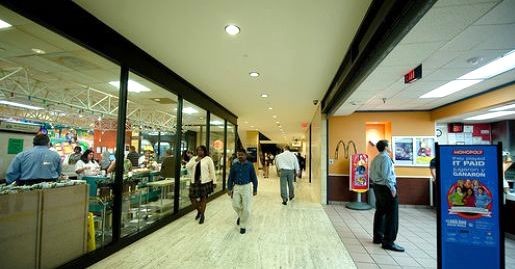The Houston Underground
Our specialization in the architecture of walking means we are keenly interested in walking systems that extend above or below traditional street-level and sidewalks and crosswalks. Minneapolis and Calgary have extensive elevated walking systems (Calgary calls theirs the “Plus Fifteen” system, or 15 feet above the sidewalk), and many cities have bits and pieces of such systems in the form of “skybridges” which connect buildings over public streets – Hong Kong has some very interesting examples. I’ll be posting on Calgary’s system soon, since I happened to visit there shortly after visiting Houston, which has perhaps the world’s most extensive underground pedestrian system, the “Tunnels.” The interconnected system runs more than 6 miles, an impressive achievement, and the map looks like a subway system, with multiple routes and transfer points. When Texans decide on something, they don’t hold back!
It’s helpful to think about these walking systems in two ways: what is the actual experience of using them, and how do they affect the traditional street-level system? The most common criticism is that these elevated or sunken systems compete with street level, and often drain it of life. A further critique is that these systems create a kind of caste system, with poorer, transit-riding citizens on the street (in the cold, heat, rain or snow), while more privileged walkers enjoy protection from the weather and greater security in a privatized system. There is certainly some validity to these concerns, though they tend to vary from city to city, and even from block to block within the system. We’ll come back to this conversation.
As for the experience, it may be worth comparing these raised and sunken walking systems to raised and sunken train systems – i.e. the subway versus the “elevated”. Underground systems are hard to beat for efficiency, but the experience of being below ground, visually cut off from the city and daylight, can be oppressive. I personally like elevated systems in many cases because you’re in the sun, you get interesting views of the city, and you can see where you’re going.
Houston’s downtown tunnel system is 20 feet below the street – their “Minus Twenty” system. I was impressed at the extensiveness of the system, and at the seemingly endless waves of walkers. At lunch hour, it felt as crowded, lively and intense as a major airport concourse or the tunnels under Rockefeller Center in New York. But it also felt claustrophobic at times, with nothing to see except the tunnel space (very few of the tunnels under the street were anything more than utilitarian, with relatively low heights) and the endless shops along each side. The shops and services were impressive in their extent and variety – you could find anything from dry cleaners to a dentist to dress shirts to food of every kind. It’s a virtual underground downtown. But it was no more appealing than walking to the gate at, say, Dulles Airport’s bland C Concourse. The exceptions were at the core of each block, where most buildings – typically corporate office towers – provide a double height space to their street level lobby, accessible by escalators. Some of these spaces were well designed, which is to say airy, open, lined with good materials, and offering diagonal glimpses up to the street and even the sky. The sense of daylight above gave me palpable relief. And these escalator lobbies were everywhere, so there was the relief of frequent options to go up. It should be said that at the top of each escalator there was usually a security guard and desk monitoring who proceeded to the elevators (controlled) and who simply walked out to the street (unrestricted).
The crowds below ground certainly contrasted with the world at street-level. I rode the escalators up at various points, and while the sidewalks weren’t completely empty, the number of people walking around was a tiny fraction of those in the tunnels. The street space was definitely dominated by moving vehicles. In the Calgary Plus-Fifteen system, the two worlds can see each other: people on the streets can see people in the skybridges and vice versa, and sometimes even connect directly via exterior stairs or escalators. But in Houston, it was really two parallel universes, with very little visual much less physical contact.

